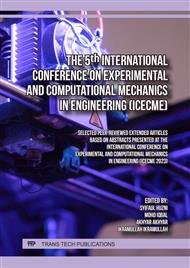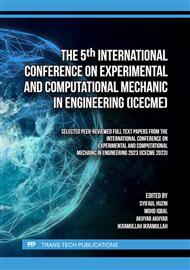[1]
M. Schönemann, C. Herrmann, P. Greschke, and S. Thiede, "Simulation of matrix-structured manufacturing systems," J. Manuf. Syst., vol. 37, p.104–112, 2015.
DOI: 10.1016/j.jmsy.2015.09.002
Google Scholar
[2]
L. Buth, N. Broderius, C. Herrmann, and S. Thiede, "Introducing agent-based simulation of manufacturing systems to industrial discrete-event simulation tools," Proc. - 2017 IEEE 15th Int. Conf. Ind. Informatics, INDIN 2017, p.1141–1146, 2017.
DOI: 10.1109/INDIN.2017.8104934
Google Scholar
[3]
S. Bandini, S. Manzoni, and G. Vizzari, "Agent based modeling and simulation: An informatics perspective," Jasss, vol. 12, no. 4, 2009, [Online]. Available: http://jasss.soc.surrey.ac.uk/12/4/4.html
Google Scholar
[4]
S. Abar, G. K. Theodoropoulos, P. Lemarinier, and G. M. P. O'Hare, "Agent Based Modelling and Simulation tools: A review of the state-of-art software," Comput. Sci. Rev., vol. 24, p.13–33, 2017.
DOI: 10.1016/j.cosrev.2017.03.001
Google Scholar
[5]
L. Zhang, L. Zhou, L. Ren, and Y. Laili, "Modeling and simulation in intelligent manufacturing," Comput. Ind., vol. 112, 2019.
DOI: 10.1016/j.compind.2019.08.004
Google Scholar
[6]
R. Sadeghi and C. Yugma, "ScienceDirect A Multi-Method Simulation Modelling Semiconductor Manufacturing Multi-Method Multi-Method Manufacturing Modelling Semiconductor," IFAC-PapersOnLine, vol. 49, no. 12, p.727–732, 2016.
DOI: 10.1016/j.ifacol.2016.07.860
Google Scholar
[7]
I. Grigorvey, "AnyLogic in Three Days," Apostilas Simulação, p.256, 2015.
Google Scholar
[8]
N. Metzner, "A comparison of agent-based and discrete event simulation for assessing airport terminal resilience," Transp. Res. Procedia, vol. 43, p.209–218, 2019.
DOI: 10.1016/j.trpro.2019.12.035
Google Scholar
[9]
K. Khedri Liraviasl, H. El Maraghy, M. Hanafy, and S. N. Samy, "A framework for modelling reconfigurable manufacturing systems using hybridized Discrete-Event and Agent-based simulation," IFAC-PapersOnLine, vol. 28, no. 3, p.1490–1495, 2015.
DOI: 10.1016/j.ifacol.2015.06.297
Google Scholar
[10]
E. Bonabeau, "Agent-based modeling: Methods and techniques for simulating human systems," Proc. Natl. Acad. Sci. U. S. A., vol. 99, no. SUPPL. 3, p.7280–7287, 2002.
DOI: 10.1073/pnas.082080899
Google Scholar
[11]
S. Mohammed Ali, M. Doolan, P. Wernick, and E. Wakelam, "Developing an agent-based simulation model of software evolution," Inf. Softw. Technol., vol. 96, no. March 2017, p.126–140, 2018.
DOI: 10.1016/j.infsof.2017.11.013
Google Scholar
[12]
K. J. Wang, J. T. Lin, and G. Weigert, "Agent-based interbay system control for a single- loop semiconductor manufacturing fab," Prod. Plan. Control, vol. 18, no. 2, p.74–90, 2007.
DOI: 10.1080/09537280600909437
Google Scholar
[13]
B. A. J. Malani and A. B. Sultan, "An Introductory of a Content Provider Agent in Higher Learning Institutions," Int. J. Comput. Sci. Issues, vol. 8, no. 4, p.48–56, 2011.
Google Scholar
[14]
L. Monostori, J. Váncza, and S. R. T. Kumara, "Agent-based systems for manufacturing," CIRP Ann. - Manuf. Technol., vol. 55, no. 2, p.697–720, 2006.
DOI: 10.1016/j.cirp.2006.10.004
Google Scholar
[15]
F. Klügl and A. L. C. Bazzan, "Agent-based modeling and simulation," AI Mag., vol. 33, no. 3, p.29–40, 2012.
DOI: 10.1609/aimag.v33i3.2425
Google Scholar
[16]
M. Farsi, J. A. Erkoyuncu, D. Steenstra, and R. Roy, "A modular hybrid simulation framework for complex manufacturing system design," Simul. Model. Pract. Theory, vol. 94, no. October 2018, p.14–30, 2019.
DOI: 10.1016/j.simpat.2019.02.002
Google Scholar
[17]
P. Tsarouchi, G. Michalos, S. Makris, T. Athanasatos, K. Dimoulas, and G. Chryssolouris, "On a human–robot workplace design and task allocation system," Int. J. Comput. Integr. Manuf., vol. 30, no. 12, p.1272–1279, 2017.
DOI: 10.1080/0951192X.2017.1307524
Google Scholar
[18]
G. Guizzi, R. Revetria, G. Vanacore, and S. Vespoli, "On the open job-shop scheduling problem: A decentralized multi-agent approach for the manufacturing system performance optimization," Procedia CIRP, vol. 79, p.192–197, 2019.
DOI: 10.1016/j.procir.2019.02.045
Google Scholar
[19]
M. Pearce, B. Mutlu, J. Shah, and R. Radwin, "Optimizing Makespan and Ergonomics in Integrating Collaborative Robots into Manufacturing Processes," IEEE Trans. Autom. Sci. Eng., vol. 15, no. 4, p.1772–1784, 2018.
DOI: 10.1109/TASE.2018.2789820
Google Scholar
[20]
G. Zheng, I. Kovalenko, K. Barton, and D. Tilbury, "Integrating Human Operators into Agent-based Manufacturing Systems: A Table-top Demonstration," Procedia Manuf., vol. 17, p.326–333, 2018.
DOI: 10.1016/j.promfg.2018.10.053
Google Scholar
[21]
I. F. Timo et al., "Agent-based communication to map and exchange shop floor data between MES and material flow simulation based on the open standard CMSD," IFAC- PapersOnLine, vol. 49, no. 12, p.1526–1531, 2016.
DOI: 10.1016/j.ifacol.2016.07.796
Google Scholar



